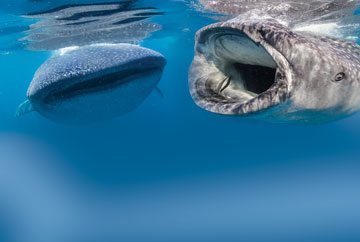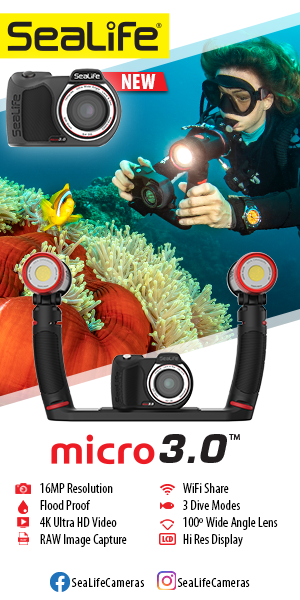When in the water with large animals it can be challenging to think about photographic nuances, what with your heart pounding and adrenalin coursing through your body and all, but after a few encounters you’ll probably be able to slow down a little and focus on composing a compelling image.

Photo by Marty Snyderman
Here’s a simple tip: Keep on the sunny side. As you face your subject and take aim, the sunlight should be coming over your shoulder. In other words, position yourself between the sun and the subject. Sunlight can help you create a pleasing natural look and the streaks of light and patterns that may appear on your subject add to the quality of the image. Using a fast shutter speed (1/125th of a second or faster) will enable you to capture patterns of light rays in your photographs (assuming you can see the patterns while you are in the water).
In the two images that accompany this article you can see the significant difference between a shot created on the sunny side, with the sun on my back, lighting up the subject, and one shot facing into the sun. There is no comparison in visual appeal and effect. The sunny-side shot wins.
The strategy of getting on the sunny side of big animals pays the biggest dividends when your subject is on or very close to the surface. Once a subject is 20-30 feet (6-9 m) deep, you will likely lose the ability to capture crisp patterns of dappled light on your subject.
Another significant benefit that comes from getting on the sunny side of Mr. Big is that you don’t need to carry a strobe. While a strobe can help you reveal details in the head and face of your subject, and help make whitish body parts appear white instead of taking on an undesirable grayish or bluish hue, there is a significant price to be paid. A strobe slows us down by adding drag. Losing speed doesn’t usually matter when photographing small, slow-moving subjects, and even most reef fishes. But when trying to get ourselves into our desired shooting positions to photograph large, fast-moving creatures, speed and fluidity not only matter, those factors often matter a lot. That extra oomph can be the difference between getting a perfect shot and watching the tail end of a big animal as it swims away.


